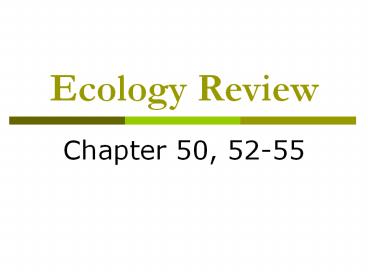Ecology Review - PowerPoint PPT Presentation
1 / 24
Title:
Ecology Review
Description:
Ecology Review Chapter 50, 52-55 * * * * What is Ecology? Define Ecology. Define the relationship between ecology and evolution. Ecology is the scientific study of ... – PowerPoint PPT presentation
Number of Views:86
Avg rating:3.0/5.0
Title: Ecology Review
1
Ecology Review
- Chapter 50, 52-55
2
What is Ecology?
- Define Ecology.
- Define the relationship between ecology and
evolution. - Ecology is the scientific study of interactions
of organisms with one another and with the
physical and chemical environment - All evolutionary change takes place in response
to ecological interactions that operate on the
population, community, ecosystem, biome and
biosphere levels
3
Distinguish between abiotic and biotic components
of an ecosystem.
- Abiotic factors
- non-living chemical physical factors
- temperature
- light
- water
- nutrients
- Biotic factors
- living components
- animals
- plants
4
- List the four levels of ecological study and give
examples of the focus of inquiry at each level. - Discuss 6 abiotic factors that influence the
distribution of organisms (temperature, water,
sunlight, wind, rocks/soil, periodic
disturbances). - How are Earths global climate patterns
determined? What effects do mountains and oceans
have on climates?
5
Distinguish between the littoral, limnetic, and
profundal zones of a lake.
6
Indicate with a () or () whether the following
are relatively high or low in oxygen level,
nutrient content and productivity.
Aquatic Biome Oxygen Level Nutrient Content Productivity
Oligotrophic Lake - -
Eutrophic Lake -
Headwater of stream - -
Turbid river -
Estuary -
7
Describe the major characteristics of the
following freshwater and marine biomes
Wetlands, Estuaries, Intertidal zones, Coral
reefs, Ocean Pelagic and Benthos.
coral reef
benthos
intertidal
8
- Locate the major biomes listed in 11 on the
attached map. Color each biome and make a key
for the different colors used. - Describe the major characteristics of the
following land biomes Tropical forests,
Savanna, Desert, Chaparral, Temperate Grassland,
Temperate Deciduous Forest, Coniferous Forest,
and Tundra.
9
Major Land Biomes
10
Land Biome Characteristics
11
Tropical rainforest
distribution equatorial precipitation very
wet temperature always warm characteristics
many plants animals, thin soil
12
Savanna
distribution equatorial precipitation seasonal,
dry season/wet season temperature always
warm characteristics fire-adapted, drought
tolerant plants herbivores fertile soil
13
Desert
distribution 30N S latitude
band precipitation almost temperature variable
daily seasonally, hot cold characteristics
sparse vegetation animals, cacti, succulents,
drought tolerant, reptiles, insects, rodents,
birds
14
Temperate Grassland
distribution mid-latitudes, mid-continents precip
itation seasonal, dry season/wet
season temperature cold winters/hot
summers characteristics prairie grasses,
fire-adapted, drought tolerant plants many
herbivores deep, fertile soil
15
Temperate Deciduous Forest
distribution mid-latitude, northern
hemisphere precipitation adequate, summer rains,
winter snow temperature moderate warm
summer/cool winter characteristics many mammals,
insects, birds, etc. deciduous trees fertile
soils
16
Coniferous Forest (Taiga)
distribution high-latitude, northern
hemisphere precipitation adequate to dry
(temperate rain forest on coast) temperature
cool year round characteristics conifers
diverse mammals, birds, insects, etc.
17
Arctic Tundra
distribution arctic, high-latitude, northern
hemisphere precipitation dry temperature cold
year round characteristics permafrost, lichens
mosses, migrating animals resident herbivores
18
Alpine Tundra
distribution high elevation at all
latitudes precipitation dry temperature cold
year round characteristics permafrost, lichens,
mosses, grasses migrating animals resident
herbivores
19
Define regulator and conformer.
- REGULATORS - organisms able to use metabolic
means to regulate their internal environments in
response to environmental changes. - Healthy mammals and birds are able to control
their internal temperatures at a very constant
level - CONFORMERS - organisms whose internal conditions
are controlled primarily by environmental
conditions. - most insects cannot control their internal body
temperature to any great degree. Rather, their
bodies are usually the same temperature as the
environment.
20
Provide 2 examples of Physiological responses,
Morphological responses, and Behavioral responses
to environmental variations.
- The beak or bill of an immature male Wrinkled
Hornbill (Aceros corrugatus) is a morphological
adaptation that is both distinct from the beaks
of most other species of birds and will change
structurally as the individual ages and matures
21
Behavioral Adaptation
- Meerkats exhibit altruism as they stand watching
for predators
22
Physiological Adaptation
- Pit vipers have long fangs that inject a
haemotoxic venom
23
Define the term population. Provide two
examples.How is population density
measured?Label and describe the three patterns
of population dispersion on the attached page.
- A group of organisms of one species living in a
certain area - Density is the number of individuals per unit
area or volume, and dispersion is the spacing of
individuals.
24
Draw a sample survivorship curve. Distinguish
between a Type I, II, and III curve. Provide an
example of an organism that would display each
type of survivorship pattern.
- Type I high mortality of adults
- Type II constant mortality
- Type III high mortality of juveniles































